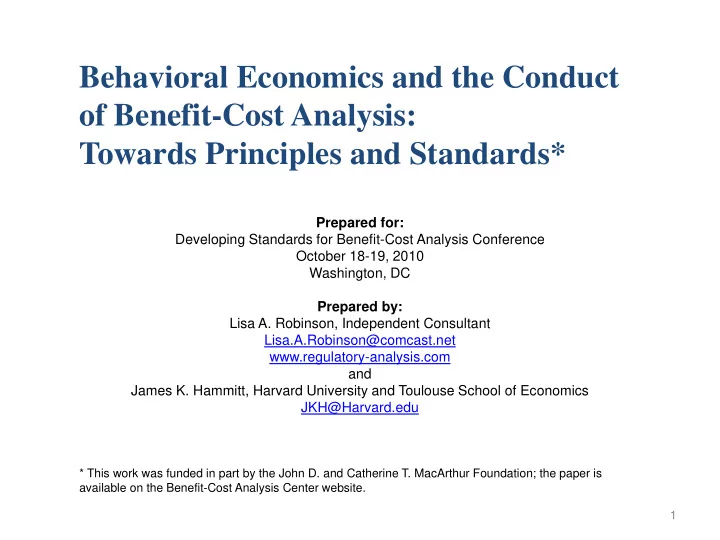

Behavioral Economics and the Conduct of Benefit-Cost Analysis: Towards Principles and Standards* Prepared for: Developing Standards for Benefit-Cost Analysis Conference October 18-19, 2010 Washington, DC Prepared by: Lisa A. Robinson, Independent Consultant Lisa.A.Robinson@comcast.net www.regulatory-analysis.com and James K. Hammitt, Harvard University and Toulouse School of Economics JKH@Harvard.edu * This work was funded in part by the John D. and Catherine T. MacArthur Foundation; the paper is available on the Benefit-Cost Analysis Center website. 1
General Premise • Benefit-cost analyses should provide information on the preferences of those affected by the policy. • Analysts should try to avoid making judgments about whether preferences are “irrational” or “erroneous.” • Estimates should be derived from studies designed to provide well-informed, thoughtful valuations to the greatest extent possible. • Where values are uncertain, analysts should use sensitivity, probabilistic, or breakeven analysis to explore the implications. 2
General Premise But... • Many issues raised by behavioral economists have not yet been explored in the context of benefit-cost analysis of social programs. • In some cases, criteria-driven review of the available research is needed (e.g., discounting). • In others, more primary research is needed to determine the effects and implications (e.g., social preferences). 3
Contents • Valuing psychological attributes of nonmarket outcomes. – Willingness to pay vs. willingness to accept compensation. – Psychological responses to risk. • Estimating time preferences. • Separating private from social preferences. • Improving valuation studies. 4
WTP vs. WTA • Currently, applied analyses often rely on WTP, due to challenges in estimating WTA. – WTA may be more appropriate in some cases. • Behavioral research suggests losses from reference state valued more highly than gains. – May lead to large disparities between WTP and WTA. • Disparities have not been well-studied for nonmarket outcomes of social programs; e.g., health risks. • In the interim, analysts should test the sensitivity of their results to changes in values. – For beneficial changes, WTA is likely to exceed WTP. 5
Psychological Responses to Risk • Illustrate with research on the value of small changes in mortality risk in a defined time period – the “Value per Statistical Life” or VSL. • The VSL may vary depending on: – Personal characteristics (e.g., income, age) – Physical risk characteristics (e.g., latency, morbidity) – Psychological risk perceptions (e.g., controllability, dread) • The influence of these factors is not necessarily inconsistent with the neoclassical economic model. 6
Psychological Responses to Risk • Some findings illustrate the influence of anomalies emphasized by behavioral economists. – Ambiguity aversion: When faced with uncertain risk information, individuals respond differently than when faced with a point estimate equivalent to the expected value of the range. – Risk weighting: Individuals tend to overweight small risks, particularly if viewed as fearsome. – Insensitivity to changes: Individuals may be insensitive to changes in small risks, reporting the same or similar values for risks of differing magnitude. 7
Psychological Responses to Risk • These findings do not necessarily create problems for the analyst. – The values used in BCA should reflect all attributes of the risk, including these factors. • Insensitivity to risk changes may be particularly troubling, however. – Are individuals indifferent to small changes in risk? Or having difficulty comprehending them? • Visual aids can improve sensitivity. – Suggests sensitivity should be a criteria for evaluating research quality. 8
Estimating Time Preferences • Typically, for intra-generational time frames, analysts discount monetary values at a constant (exponential) rate, usually ~ 3% to 7%. – Reflects simplifying assumptions more than theory. • Behavioral research suggests that: – Preferences may differ depending on the time frame. – Discounting may be hyperbolic rather exponential. – For example, some research suggests near-term rates ~ 40%, and long-term rates ~ 4%. • Different short vs. long-term rates may lead to inconsistent decisions depending on the time frame. 9
Estimating Time Preferences • High near-term rates are useful in predicting behavior. – Reflect impulsive behavior and self-control problems. • Lower, long-term rates seem more appropriate for discounting monetary values in BCA. – Planning horizon for social programs is consistent with longer- term decisionmaking. – Social programs are focused on providing lasting (rather than temporary) improvements in welfare. • Aggregate (market) rather than individual rates reflect opportunity costs of investing in new programs. 10
Separating Private from Social Preferences • Typically, efficiency and equity are addressed separately. – For efficiency, focus on self-regarding values (e.g., WTP for own risk reductions). – For equity, describe distribution without valuing it. • Other-regarding preferences (e.g., altruism) are recognized within the neo-classical framework. – Difficult to distinguish paternalistic vs. non- paternalistic altruism. – Typically not explicitly included in the analysis. 11
Separating Private from Social Preferences Motivations for other-regarding preferences: • Social welfare (increase total welfare by helping others, particularly those less-well off). • Difference aversion (reduce differences between self and others). • Reciprocity (reward or penalize others depending on perceived fairness of their actions). • Relative position (“keeping up with the Joneses”). 12
Separating Private from Social Preferences • Concerns identified in behavioral research are largely based on experiments. – More field research is needed to determine effects in complex “real world” settings. • Analysts need to carefully separate general attitudes from attitudes that differ by outcome. – For example, overall “warm glow” vs. paternalistic attitudes towards health gains. • Analysts should consider whether values (intentionally or inadvertently) include other-regarding preferences. 13
Improving Valuation Studies • Continual improvement is needed to ensure that values reflect well-informed, thoughtful preferences to the greatest extent possible. • Stated-preference researchers have long incorporated behavioral considerations into study design and analysis. • Less attention has been paid to behavioral concerns in revealed-preference research. – Beshears et al. (2008): revealed (or positive) preferences (the choices people actually make) vs. normative preferences (the choices people think they should make). – Factors that help distinguish these preferences (e.g., active decisionmaking) may be useful for improving study design and interpretation. 14
Recommend
More recommend